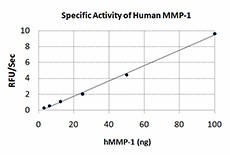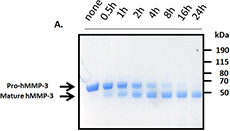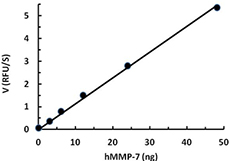- Regulatory Status
- RUO
- Other Names
- Interstitial collagenase, Fibroblast collagenase, MMP1, MMP
- Ave. Rating
- Submit a Review
- Product Citations
- publications

-

The activity of human MMP-1 was measured with 10 µM of fluorogenic MMP substrate, Mca-KPLGLDpa-AR, in the presence of 3.125, 6.25, 12.5, 25, 50, 100 ng of activated human MMP-1. -

Human MMP-1 (~54 kD) was activated by1 mM of p-Aminophenylmercuric acetate (APMA) at different time points at 37°C. After 1 h of activation, the mature form hMMP-1 (~45 kD) could be readily observed. Samples at reducing and non-reducing condition were resolved in a SDS-PAGE. Molecular weight markers at 250, 150, 100, 70, 55 kD were labeled here. Protein per lane: 2.5 µg
MMP-1 is a member of matrix metalloproteinase family proteins (MMPs); members of this family are structurally related, zinc-containing enzymes that degrade the extracellular matrix (ECM) and connective tissue proteins. MMP-1 consists of a prodomain which is cleaved upon activation: a catalytic domain containing the zinc binding site, a short hinge region, and a carboxyl terminal (hemopexin-like repeats) domain. Substrates of MMP-1 include collagen I, II, III, VII, VIII, and X as well as casein, gelatin, alpha1 antitrypsin, myelin basic protein, L Selectin, pro-TNF, IL-1β, IGFBP3, IGFBP5, pro-MMP-2, and pro-MMP-9. In addition, chemokines are substrates for MMP-1. CCL2, CCL7, CCL8, and CCL13 are catalytically cleavage by MMP-1 to produce receptor antagonists. CXCL5 and CXCL12 are also substrates for MMP-1. TIMPs inhibit MMPs in a 1:1 inhibitor to enzyme ratio through interaction of the N-terminal domain of the TIMP molecule with the active site of the MMP. MMPs are involved in the breakdown of ECM in normal physiological processes, such as embryonic development, reproduction, and tissue remodeling as well as in disease processes such as arthritis and metastasis. MMP-1 is overexpressed in invasive melanoma, colorectal, and esophageal cancers. Importantly, MMP-1 expression was shown to increase progressively with tumor stage.
Product DetailsProduct Details
- Source
- Human MMP-1, amino acids (Phe20-Asn469) (Accession# NP_002412.1), is expressed with N-terminal His9-SGGGSGGGIEGR tag in 293E cell line.
- Molecular Mass
- Predicted molecular mass of approximately 54 kD. The protein migrates at about 55 kD in DTT-reducing conditions and about 60 kD in non-reducing condition by SDS-PAGE.The N-terminal amino acid is Histidine.
- Formulation
- 0.22 µm filtered protein solution is in TCN (25 mM TRIS, 10 mM CaCl2, 150 mM NaCl, pH 7.5).
- Endotoxin Level
- Less than 1.0 EU per µg of protein as determine by the LAL method
- Concentration
- 10 and 25 µg sizes are bottled at 200 µg/mL. 100 µg size and larger sizes are lot-specific and bottled at the concentration indicated on the vial. To obtain lot-specific concentration and expiration, please enter the lot number in our Certificate of Analysis online tool.
- Storage & Handling
- Unopened vial can be stored at -20°C or -70°C for six months. For maximum results, quick spin vial prior to opening. Avoid repeated freeze/thaw cycles.
- Activity
- Human MMP-1 cleaves the peptide substrate Mca-KPLGL-Dpa-AR-NH2 with an activity above 200 pmol/min/µg.
- Application
-
Bioassay
- Application Notes
-
This protein is in the latent form and needs to be activated for bioassay.
BioLegend carrier-free recombinant proteins provided in liquid format are shipped on blue-ice. Our comparison testing data indicates that when handled and stored as recommended, the liquid format has equal or better stability and shelf-life compared to commercially available lyophilized proteins after reconstitution. Our liquid proteins are verified in-house to maintain activity after shipping on blue ice and are backed by our 100% satisfaction guarantee. If you have any concerns, contact us at tech@biolegend.com.
Antigen Details
- Structure
- Monomer
- Distribution
-
MMP-1 is expressed by fibroblasts, keratinocytes, endothelial cells, monocytes, and macrophages.
- Function
- Degradation of ECM and connective tissue proteins. Angiogenesis, tissue remodeling, cancer metastasis. MMP-1 regulates chemokine activity. MMP1 is inhibited by TIMPs, α2-macroglobulin (inhibitor of MMPs in bodily fluids). TNFα downregulates TIMPs and enhances the expression of MMPs.
- Interaction
- Extracellular matrix proteins
- Ligand/Receptor
- TIMPs
- Bioactivity
- hMMP-1 cleaves a peptide substrate Mca-KPLGL-Dpa-AR-NH2
- Biology Area
- Angiogenesis, Cell Adhesion, Cell Biology, Neuroinflammation, Neuroscience, Stem Cells
- Molecular Family
- Enzymes and Regulators
- Antigen References
-
1. Nagase H and Woessner JF Jr. 1999. J. Biol. Chem. 274:21491.
2. Kader AK, et al. 2007. Clin. Cancer Res. 13:2614.
3. Gill SE and Parks WC. 2008. Int. J. Biochem. Cell Biol. 40:1334.
4. Mazor R, et al. 2013. J. Biol. Chem. 288:598.
5. Sommer K, et al. 2013. PLos One 8:e73992. - Gene ID
- 4312 View all products for this Gene ID
- UniProt
- View information about MMP-1 on UniProt.org
Related FAQs
- Why choose BioLegend recombinant proteins?
-
• Each lot of product is quality-tested for bioactivity as indicated on the data sheet.
• Greater than 95% Purity or higher, tested on every lot of product.
• 100% Satisfaction Guarantee for quality performance, stability, and consistency.
• Ready-to-use liquid format saves time and reduces challenges associated with reconstitution.
• Bulk and customization available. Contact us.
• Learn more about our Recombinant Proteins. - How does the activity of your recombinant proteins compare to competitors?
-
We quality control each and every lot of recombinant protein. Not only do we check its bioactivity, but we also compare it against other commercially available recombinant proteins. We make sure each recombinant protein’s activity is at least as good as or better than the competition’s. In order to provide you with the best possible product, we ensure that our testing process is rigorous and thorough. If you’re curious and eager to make the switch to BioLegend recombinants, contact your sales representative today!
- What is the specific activity or ED50 of my recombinant protein?
-
The specific activity range of the protein is indicated on the product datasheets. Because the exact activity values on a per unit basis can largely fluctuate depending on a number of factors, including the nature of the assay, cell density, age of cells/passage number, culture media used, and end user technique, the specific activity is best defined as a range and we guarantee the specific activity of all our lots will be within the range indicated on the datasheet. Please note this only applies to recombinants labeled for use in bioassays. ELISA standard recombinant proteins are not recommended for bioassay usage as they are not tested for these applications.
- Have your recombinants been tested for stability?
-
Our testing shows that the recombinant proteins are able to withstand room temperature for a week without losing activity. In addition the recombinant proteins were also found to withstand four cycles of freeze and thaw without losing activity.
- Does specific activity of a recombinant protein vary between lots?
-
Specific activity will vary for each lot and for the type of experiment that is done to validate it, but all passed lots will have activity within the established ED50 range for the product and we guarantee that our products will have lot-to-lot consistency. Please conduct an experiment-specific validation to find the optimal ED50 for your system.
- How do you convert activity as an ED50 in ng/ml to a specific activity in Units/mg?
-
Use formula Specific activity (Units/mg) = 10^6/ ED50 (ng/mL)
 Login / Register
Login / Register 














Follow Us